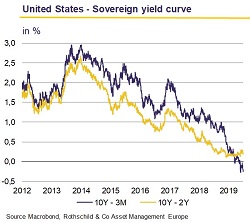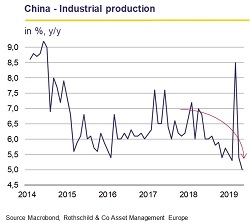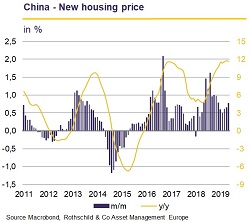Asset Management Europe: Monthly Letter – July 2019

Marc-Antoine Collard, Chief Economist, Head of Economic Research, Asset Management, Europe
Economic environment
The pace of global economic expansion remains low and below trend, affected by the further escalation of trade tensions. Even the US's economic statistics have suffered a widespread - albeit gradual - deterioration. Investment and global trade were weaker than expected at the beginning of the year, and falling sovereign rates in most countries reflects the fragile momentum of global growth, which is subject to significant downward risks. The equity markets, however, still anticipate a rebound of the global economy in H2 2019, as a result of uncertainties dissipating and resolutely accommodative central banks coming to the rescue.
The prospect of further global monetary easing, including a possible return of asset purchase programs (QE), has increased, which is supporting equity markets. Yet, certain factors dictate prudence regarding these expectations that may seem, at first glance, overly optimistic. For instance, no less than three rate cuts are expected this year in the US, even though the last Federal Open Market Committee (FOMC) meeting showed that a majority of its members did not envisage any rate changes, facing a major dilemma. On the one hand, they don't want to react prematurely to events (i.e. trade war) that could reverse quickly. On the other, the Fed might have to move more promptly than in the past because it does not have as much room to cut rates as in previous downturns.
What's more, the expected impact of these measures on future economic growth remains an open question. Undoubtedly, in the aftermath of the Financial Crisis, central banks supported economic activity through many channels. Indeed, they instilled a climate of confidence for businesses and financial markets, thus encouraging investment, and the fall in interest rates - and thus the cost of borrowing - boosted credit creation and, in turn, economic growth.
However, these effects are unlikely to be linear. Since the cost of borrowing is already low and hardly a hindrance for most businesses, a rate cut today will not do much to move the needle on growth and investment spending. In addition, it cannot be ruled out that central banks might find their interest rate to be at such a level from where any further decline would damage the economy more than it would help - due to its negative impact on the profitability of banks, therefore hurting their ability to grant credit.
In fact, despite the unprecedented shift in the Fed's position and the adoption of a less restrictive tone, the US 10 years/3 months yield curve remains inverted. This certainly captures doubts among bond investors regarding the ability of central banks to reverse meaningfully the global economic slowdown.
Click the image to enlarge
Meanwhile, the easing of trade tensions is also perceived as a production contributing factor to the improvement of the world economy. Certainly, the resumption of dialogue between the US and China on the margins of the G20 is good news, and the outcome placed investors in a Goldilocks-like situation: good enough to prevent escalation, but not too good to dissuade the Fed from cutting interest rates. However, if the fears of short-term escalation are reduced, there is little evidence of a durable solution that might be found quickly, and as such the conflict remains unresolved. Also, contrary to the meeting last November in which President Trump pledged to keep the truce for a minimum of three months, this time the US retains the option of increasing pressure on China at all times, thanks to the threat of further tariff increases, as well as new sanctions against the Chinese technology giant Huawei.
What's more, a thick fog surrounds the progress of discussions with Europe, as the US Department of Commerce recently decided to add USD4 bn of European imports to the existing list of USD21 bn worth of products to be taxed in retaliation for what the Trump Administration considers to be abusive subsidies to aircraft manufacturers from the European Union. This adds to the risks surrounding the European automotive sector, also threatened by tariffs.
While predicting and quantifying the overall economic consequences of escalating trade tensions is complicated given the complexity and high level of value chain interlinking, the introduction of tariff barriers increases uncertainty, which undeniably penalises global growth. In that regard, it seems most businesses have adopted a wait-and-see attitude, postponing, questioning or even mothballing their investment decisions. Indeed, the Markit business confidence index in the global manufacturing sector fell to its lowest level for over six-and-a-half years and posted back-to-back sub-50 readings, in contraction territory, for the first time since the second half of 2012.
Click the image to enlarge
Will stimulus measures in China be able to reverse this trend? For now, the effectiveness of the various measures has not lived up to expectations. Although a hard landing remains highly unlikely, the deterioration of most of China's economic indicators continues, and the effects of recent measures of economic support are much more apparent in asset prices - notably housing - than in the real economy.
Click the images to enlarge
Yet, a housing bubble is certainly something China wants to avoid. While the equity markets remain buoyed by the hope of additional measures, the risks to financial stability are far from negligible and the Chinese authorities' room for manoeuvre is apparently limited. Once again, the bond market seems to have understood it well.
Download the PDF version Monthly Letter (678 KB)



